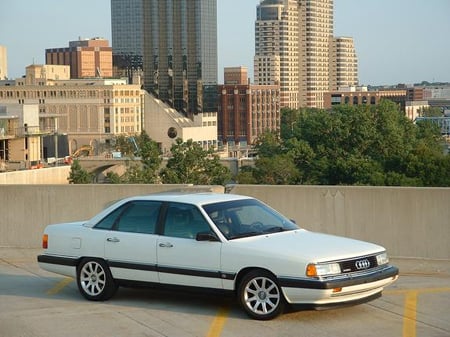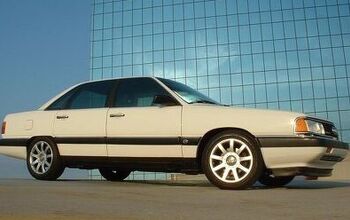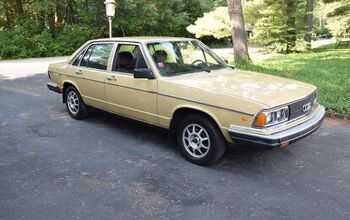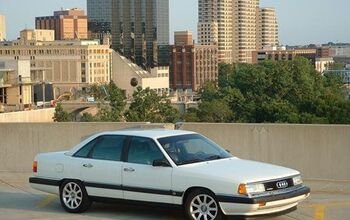In Defense of: The Audi 5000

[Update: this article has been updated and re-published here]
When I first heard about the Audi “sudden unintended acceleration” segment on CBS’s 60 Minutes in 1986, I knew immediately that they were blowing smoke. Literally.
A few years earlier, I was part of a TV crew shooting an educational program. Legendary race-car driver Parnelli Jones was the guest celebrity. The producer offered to take us to lunch in his 1976 Cadillac Fleetwood Brougham. We hopped in. Parnelli took the wheel.
Parnelli fired up the Caddy’s big V8, dropped it in gear and floored it- with his other foot on the brake. The left rear wheel lit up in a screeching howl; the car was soon engulfed in a cloud of acrid smoke. The Caddy didn’t move an inch- obviously. And neither did Parnelli, glancing at the wincing producer with his wicked grin. I had assumed (wrongly) that race-car drivers grew up eventually.
The experience seared in a lesson in basic automobile physics: brakes are always more powerful than engines, even when they have 500 cubic inches (8.2 liters). Too bad we didn’t have our cameras running. We could have made a graphic rebuttal to 60 Minutes’ fraudulent destruction of Audi.
Let’s set the scene. It’s 1984. Audi sales had shot up 48 percent on the strength of their new aero-dynamic 5000, the hot new weapon in the perpetually-escalating suburban driveway status war. It was a stunning piece. Audi was on a roll.
Suddenly, the war turned bloody. Moms in runaway Audi 5000’s were mowing down their little kids in the driveway and pinning granny against the far garage wall.
This hadn’t happened with the Olds Cutlass Supreme Coupe, the “hot” suburban car Mom traded in for her Audi. The German car certainly felt different. Unlike the Olds’ wide push-bar brake pedal– that some Americans still operated with their left feet– the Audi had that weird, small brake pedal, kinda’ close to the gas pedal.
And these Audis had a mind of their own. No matter how hard Mom pushed on the brake pedal, the Audi kept on going, right through the garage door. This despite the fact that the little five-cylinder mill only cranked out 130 horsepower. And the top-notch four-wheel disc brake system probably could generate well over 600 g-force horsepower.
Apparently, the brakes were failing at exactly the same moment that the gas pedal decided it had a mind of its own. Perfectly plausible, at least to the 60 Minutes crew.
About as plausible as ignoring the police report of the most dramatic victim on the show, Kristi Bradosky, who ran over her six year old son. That report said “Bradosky’s foot slipped off the brake pedal onto the gas pedal accelerating the auto.” Denial isn’t just a river.
Ed Bradley’s 17 minute “investigative report” aired on November 23, 1986. Between interviews of the teary-eyed “victims” (drivers) of unintended acceleration swearing their feet were on the brake pedal, CBS showed a clip of a driverless Audi lurching forward on its own.
Viewers didn’t see the canister of compressed air on the passenger-side floor with a hose running to a hole drilled in the transmission. An “expert” had rigged the Rube Goldberg device to shift the big Audi into drive and, like any automatic-equipped car, move forward (unless the brakes are depressed).
The clip was blatantly deceptive AND totally irrelevant. Nobody claimed driverless Audis were taking off and killing kids. Mom was always at the wheel, pushing the 5000’s “brake” pedal with all her might.
In 1989, after three years of studying the blatantly obvious, the National Highway Traffic Safety Administration (NHTSA) issued their report on Audi’s “sudden unintended acceleration problem.” NHTA’s findings fully exonerated Audi and some other implicated foreign makes.
The report concluded that the Audi’s pedal placement was different enough from American cars’ normal set-up (closer to each other) to cause some drivers to mistakenly press the gas instead of the brake. 60 Minutes did not retract their piece; they called the NHTSA report “an opinion.”
A flood of lawsuits was already washing over Audi, not to mention a tsunami of bad publicity. Audi took a questionable stance: they didn’t blame the drivers for the problem, even after the NHTSA report came out. Hey, the customer’s always right, and we sure wouldn’t want to make our American customers look stupid. Anything but that.
So the German automaker took it on the chin. Audi sales collapsed, from 74k units in 1984 to 12k by 1991. The timing added insult to injury; sales fell during the same years when Lexus arrived to battle for the hearts and wallets of America’s up-scale consumers. The Japanese autos quickly became the new suburban driveway prestige weapon.
Audi’s wanna-be-Lexus drivers launched a class action suit charging lost resale value. No wonder the brand almost abandoned the U.S. in 1993. It’s a killer market.

More by Paul Niedermeyer
Latest Car Reviews
Read moreLatest Product Reviews
Read moreRecent Comments
- Jeff Self driving cars are not ready for prime time.
- Lichtronamo Watch as the non-us based automakers shift more production to Mexico in the future.
- 28-Cars-Later " Electrek recently dug around in Tesla’s online parts catalog and found that the windshield costs a whopping $1,900 to replace.To be fair, that’s around what a Mercedes S-Class or Rivian windshield costs, but the Tesla’s glass is unique because of its shape. It’s also worth noting that most insurance plans have glass replacement options that can make the repair a low- or zero-cost issue. "Now I understand why my insurance is so high despite no claims for years and about 7,500 annual miles between three cars.
- AMcA My theory is that that when the Big 3 gave away the store to the UAW in the last contract, there was a side deal in which the UAW promised to go after the non-organized transplant plants. Even the UAW understands that if the wage differential gets too high it's gonna kill the golden goose.
- MKizzy Why else does range matter? Because in the EV advocate's dream scenario of a post-ICE future, the average multi-car household will find itself with more EVs in their garages and driveways than places to plug them in or the capacity to charge then all at once without significant electrical upgrades. Unless each vehicle has enough range to allow for multiple days without plugging in, fighting over charging access in multi-EV households will be right up there with finances for causes of domestic strife.


































Comments
Join the conversation
It is disheartening to see all the adulation on TV and in print, of Don Hewitt, mastermind of 60 Minutes, now that he has passed on, when thinking of all the negatives that resulted from the Audi 5000 debacle. He was a pioneer and did many good things for broadcasting. Too bad his ethics weren't as good. I have not watched 60 Minutes since (or many other expose programs as well).
[…] Here’s an example from a pretty typical remembrance of what happened, from a 2007 article written “in defense of Audi”: […]